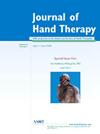Effectiveness of chitosan phonophoresis on ulnar nerve conduction velocity, pain relief, and functional outcomes for mild to moderate cubital tunnel syndrome: A double-blind randomized controlled trial
IF 2.1
4区 医学
Q2 ORTHOPEDICS
引用次数: 0
Abstract
Background
Cubital tunnel syndrome (CBTS) impairs hand function, with limited conservative options often leading to surgery. Chitosan neuroregenerative effects delivered via phonophoresis provide a rationale for testing this emerging treatment approach.
Purpose
The primary goal of this research was to assess the impact of chitosan phonophoresis on the conductivity of the ulnar nerve, as well as its effects on pain levels and functional outcomes in individuals diagnosed with mild to moderate CBTS.
Study design
Double-blind randomized controlled trial.
Methods
This was a prospective, double-blinded, randomized controlled study. The participants consisted of 54 individuals aged between 20–35 years who were randomly assigned using block randomization. The control group (n = 27) received standard hand therapy alone, while the experimental group (n = 27) received both standard hand therapy and chitosan phonophoresis. Both groups underwent three treatment sessions per week, each lasting for 60–72 minutes, over a period of five weeks. Pre- and post-intervention evaluations included assessments of ulnar nerve conduction velocity (NCV), pain assessment using the numerical pain rating scale (NPRS), as well as hand function evaluated using the Quick Disabilities of Arm Shoulder Hand (QuickDASH) questionnaire.
Results
After the intervention, the experimental group significantly improved in all outcome measures compared to the control group. Accordingly, ulnar NCV (MD = 2.233 m/sec; CI = 1.63:2.83; p < 0.001; η2p = 0.516), NPRS (MD = −1.11; CI = −1.71: −0.50; p < 0.001; η2p = 0.208) and QuickDASH (MD = −2.72; CI = −4.54:0.87; p < 0.007; η2p = 0.133).
Conclusions
The study findings suggest that chitosan phonophoresis may have the potential as a supplementary treatment to hand therapy for individuals with mild to moderate CBTS. This approach demonstrated significant improvements in nerve conduction, pain reduction, and enhancement of hand function.
壳聚糖音波透入疗法对轻中度肘隧道综合征尺神经传导速度、疼痛缓解和功能疗效的影响:双盲随机对照试验。
背景:眶管综合征(CBTS)损害手部功能,有限的保守疗法往往导致手术。目的:本研究的主要目的是评估壳聚糖音波透入疗法对尺神经传导性的影响,以及对被诊断为轻度至中度CBTS患者的疼痛程度和功能结果的影响:研究设计:双盲随机对照试验:这是一项前瞻性、双盲、随机对照研究。研究对象包括 54 名年龄在 20-35 岁之间的患者,采用整群随机法进行随机分配。对照组(27 人)只接受标准手部疗法,实验组(27 人)则同时接受标准手部疗法和壳聚糖音波透入疗法。两组患者每周接受三次治疗,每次 60-72 分钟,为期五周。干预前后的评估包括尺神经传导速度(NCV)评估、使用疼痛评分量表(NPRS)进行的疼痛评估,以及使用手臂肩部手部快速残疾(QuickDASH)问卷进行的手部功能评估:结果:干预后,与对照组相比,实验组在所有结果指标上都有明显改善。因此,尺侧 NCV(MD = 2.233 米/秒;CI = 1.63:2.83;P 2P = 0.516)、NPRS(MD =-1.11;CI =-1.71:-0.50;P 2P = 0.208)和 QuickDASH(MD =-2.72;CI =-4.54:0.87;P 2P = 0.133):研究结果表明,壳聚糖声波透入疗法有可能成为轻度至中度 CBTS 患者手部治疗的辅助疗法。这种方法在神经传导、减轻疼痛和增强手部功能方面都有明显改善。
本文章由计算机程序翻译,如有差异,请以英文原文为准。
求助全文
约1分钟内获得全文
求助全文
来源期刊

Journal of Hand Therapy
医学-外科
CiteScore
3.50
自引率
10.00%
发文量
65
审稿时长
19.2 weeks
期刊介绍:
The Journal of Hand Therapy is designed for hand therapists, occupational and physical therapists, and other hand specialists involved in the rehabilitation of disabling hand problems. The Journal functions as a source of education and information by publishing scientific and clinical articles. Regular features include original reports, clinical reviews, case studies, editorials, and book reviews.
 求助内容:
求助内容: 应助结果提醒方式:
应助结果提醒方式:


